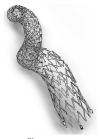Biomechanical Forces and Atherosclerosis: From Mechanism to Diagnosis and Treatment
- PMID: 31362692
- PMCID: PMC7536809
- DOI: 10.2174/1573403X15666190730095153
Biomechanical Forces and Atherosclerosis: From Mechanism to Diagnosis and Treatment
Abstract
The article provides an overview of current views on the role of biomechanical forces in the pathogenesis of atherosclerosis. The importance of biomechanical forces in maintaining vascular homeostasis is considered. We provide descriptions of mechanosensing and mechanotransduction. The roles of wall shear stress and circumferential wall stress in the initiation, progression and destabilization of atherosclerotic plaque are described. The data on the possibilities of assessing biomechanical factors in clinical practice and the clinical significance of this approach are presented. The article concludes with a discussion on current therapeutic approaches based on the modulation of biomechanical forces.
Keywords: Atherosclerosis; circumferential wall stress; mechanosensing; peripheral artery disease; plaque progression; wall shear stress.
Copyright© Bentham Science Publishers; For any queries, please email at epub@benthamscience.net.
Figures



Similar articles
-
Biomechanical factors in atherosclerosis: mechanisms and clinical implications.Eur Heart J. 2014 Nov 14;35(43):3013-20, 3020a-3020d. doi: 10.1093/eurheartj/ehu353. Epub 2014 Sep 17. Eur Heart J. 2014. PMID: 25230814 Free PMC article.
-
Biomechanical factors as triggers of vascular growth.Cardiovasc Res. 2013 Jul 15;99(2):276-83. doi: 10.1093/cvr/cvt089. Epub 2013 Apr 10. Cardiovasc Res. 2013. PMID: 23580605 Review.
-
Thin-cap fibroatheroma rupture is associated with a fine interplay of shear and wall stress.Arterioscler Thromb Vasc Biol. 2014 Oct;34(10):2224-31. doi: 10.1161/ATVBAHA.114.303426. Epub 2014 Jul 24. Arterioscler Thromb Vasc Biol. 2014. PMID: 25060797 Review.
-
MicroRNAs in flow-dependent vascular remodelling.Cardiovasc Res. 2013 Jul 15;99(2):294-303. doi: 10.1093/cvr/cvt096. Epub 2013 Apr 23. Cardiovasc Res. 2013. PMID: 23612583 Review.
-
Shear stress in atherosclerotic plaque determination.DNA Cell Biol. 2014 Dec;33(12):830-8. doi: 10.1089/dna.2014.2480. DNA Cell Biol. 2014. PMID: 25165867 Review.
Cited by
-
To patch or not to patch: is that the real question? The role of hemodynamics in carotid endarterectomy. Illustrative cases.J Neurosurg Case Lessons. 2025 Apr 7;9(14):CASE24840. doi: 10.3171/CASE24840. Print 2025 Apr 7. J Neurosurg Case Lessons. 2025. PMID: 40194457 Free PMC article.
-
Non-Invasive Pulsatile Shear Stress Modifies Endothelial Activation; A Narrative Review.Biomedicines. 2022 Nov 28;10(12):3050. doi: 10.3390/biomedicines10123050. Biomedicines. 2022. PMID: 36551807 Free PMC article. Review.
-
The effective constituent puerarin, from Pueraria lobata, inhibits the proliferation and inflammation of vascular smooth muscle in atherosclerosis through the miR-29b-3p/IGF1 pathway.Pharm Biol. 2023 Dec;61(1):1-11. doi: 10.1080/13880209.2022.2099430. Pharm Biol. 2023. PMID: 36537316 Free PMC article.
-
Mechanosensing and Mechanosignal Transduction in Atherosclerosis.Curr Atheroscler Rep. 2023 Oct;25(10):711-721. doi: 10.1007/s11883-023-01139-6. Epub 2023 Aug 24. Curr Atheroscler Rep. 2023. PMID: 37615786 Review.
-
Ginsenoside Rc ameliorated atherosclerosis via regulating gut microbiota and fecal metabolites.Front Pharmacol. 2022 Sep 15;13:990476. doi: 10.3389/fphar.2022.990476. eCollection 2022. Front Pharmacol. 2022. PMID: 36188559 Free PMC article.
References
-
- Kwak BR, Bäck M, Bochaton-Piallat ML, et al. 2014.
-
- Papaioannou T.G., Stefanadis C. Vascular wall shear stress: Basic principles and methods. Hellenic J. Cardiol. 2005;46(1):9–15. - PubMed
Publication types
MeSH terms
LinkOut - more resources
Full Text Sources
Medical

